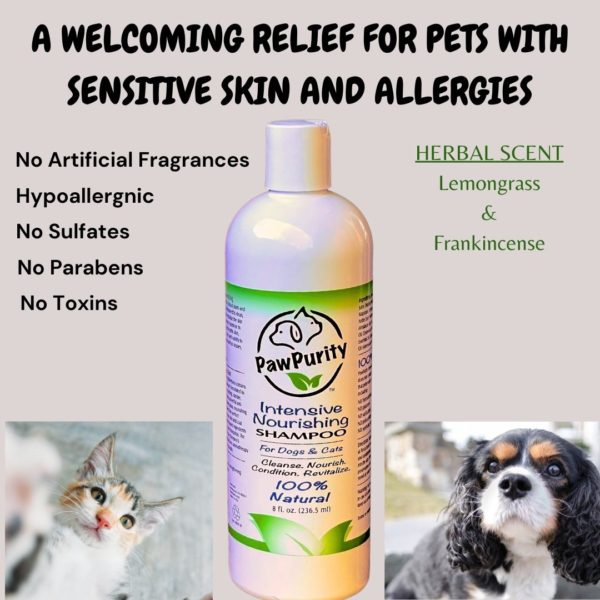If you’re a dog owner, you know that your furry friend is a part of the family and allergy-caused dog atopic dermatitis is a concern. Getting your pooch properly diagnosed and treated for any allergies it may have. In this blog post, we’ll discuss the symptoms and treatment options for one common type of doggy allergy: atopic dermatitis.
Causes of Atopic Dermatitis in Dogs
Atopic dermatitis is a common allergic skin disease in dogs. It could be caused by an allergy to something in the environment, such as pollen, dust mites, or mold. It also can be caused by the shampoo and products put on the dog. This type of allergy causes the dog’s immune system to overreact, leading to inflammation and itchiness of the skin.
Several factors can contribute to atopic dermatitis in dogs. One is “Genetics”. If a dog’s parents or grandparents had atopic dermatitis, the dog is more likely to develop the condition. Another factor is the “Environment”. Dogs that live in urban areas with high levels of pollution are more likely to develop atopic dermatitis than dogs that live in rural areas.
The best way to prevent atopic dermatitis is to avoid exposure to things that trigger the allergy. Unfortunately, this cannot be easy, as many of these triggers are in everyday environments.
Symptoms of Atopic Dermatitis
Atopic dermatitis is the most common form of allergy in dogs. It’s also known as allergic inhalant dermatitis, seasonal allergies, or “the itchy dog.” Here are the major signs that your furry friend may have atopic dermatitis:
- Itching and Scratchy Skin: The first sign is usually itching and scratchy skin. Your dog may start to lick or chew at their paws or body more than usual.
- Hot Spots: Hot spots are areas of inflamed, irritated skin that are caused by excessive licking and scratching. They can be painful and may bleed or ooze pus.
- Hair Loss: Hair loss is another common symptom of atopic dermatitis. Your dog may lose patches of hair, or its coat may become thin.
How is Atopic Dermatitis Diagnosed in Dogs?
Atopic dermatitis can be challenging to diagnose because the symptoms vary greatly from dog to dog. However, the most common symptom of atopic dermatitis is itchy, inflamed skin. Other symptoms may include hair loss, scabbing, and crusting. If you suspect your dog has atopic dermatitis, try using a more natural and gentle shampoo such as PawPurity Intensive Nourishing Shampoo, which was developed to create a Ph balanced and healthy skin. Dog owners love this shampoo because every ingredient is natural and serves a purpose in keeping your pet’s skin in tip top condition. Ingredients are: olive oil-based cleanser, aloe vera juice, calendula, yucca root, horsetail, red clover, nettle leaf, witch hazel, apple cider vinegar, Himalayan salt, vitamin E, frankincense, marjoram, cedarwood and lemongrass. Using this natural dog shampoo can verify or rule out product-caused allergies. If you see improvement, don’t be afraid to use it as often as every two weeks until the dermatitis goes away. If you don’t see improvement, schedule an appointment with your veterinarian.
During the appointment, your veterinarian will take a complete medical history and perform a physical examination. She may also recommend allergy testing. Allergy testing can be achieved with blood tests or skin biopsies. These tests can help confirm the diagnosis and identify which allergens are triggering your dog’s symptoms.
Treatment Options for Dog Allergies – Atopic Dermatitis Specifically
There are several different treatment options for dog allergies, but atopic dermatitis specifically can be a tricky condition to treat. However, here are a few things you can do to help your furry friend feel better:
- Talk to your vet about antihistamines or other medications that can help relieve symptoms. “Corticosteroids” are the most common medication used to treat atopic dermatitis, and they come in various forms, including creams, ointments, gels, and oral pills.
- Try an allergy-specific diet prescribed by your vet. Omega-3 fatty acids may also be recommended by your veterinarian to help reduce inflammation.
- Use a humidifier in your home to help keep the air moist and reduce irritation.
- Keep your dog clean and well-groomed, using Organic Hypoallergenic Shampoos and conditioners if necessary. Avoid using products containing artificial fragrances or other irritants on your dog’s skin or coat.
- Use only gentle, unscented laundry detergent when washing your dog’s bedding or clothing.
Managing Atopic Dermatitis Flare-ups
Several different treatment options are available for dog allergies, specifically atopic dermatitis. The most important thing is to identify the allergen and avoid exposure to it as much as possible. Managing atopic dermatitis can be difficult, but there are some things you can do to help your dog feel better.
First, it’s essential to identify the triggers that cause your dog’s flare-ups. Then, if you can avoid them, you’ll be able to reduce the frequency and severity of the flare-ups. Common triggers include pollen, dust mites, mold, and certain cleaning products. Once you know what triggers your dog’s flare-ups, you can take steps to avoid them.
Pet Info – Keep up to date!
Dog Health
Aloe Vera for Dogs – Why It’s Such a Potent Ingredient
by Lisa Porter
on Apr 07 2023
Are you looking for a natural way to care for your dog’s skin and coat? Shampoos and sprays that have specific types of aloe vera for dogs is the answer. From soothing dry, itchy skin to helping heal wounds, aloe vera can provide numerous benefits for your pup. But not all aloe vera is created equal and some should never be used on your dog.
Flea & Tick Protection, Skin, Coat & Paw Care
Cat Dermatitis – Causes & Cures
by Lisa Porter
on Jan 05 2023
Are you a cat parent trying to figure out what is causing your sweet little kitty’s skin irritation? If so, you may be dealing with dermatitis – an inflammation caused most often by allergies. Thankfully, this common issue can usually be managed and cured at home with the help of natural and/or medicinal antibiotics and topical creams. In this blog post, we will discuss some common causes of cat dermatitis and various treatments that could provide relief for your feline friend.
Pet Health & Skin
Managing Pet Dander – Tips and Tricks for a Dander-Free Home
by Lisa Porter
on May 31 2023
Imagine coming home after a long day, eagerly anticipating the warm welcome of your beloved pet. However, for individuals with allergies, this scenario often transforms into a distressing ordeal. Pet dander, a common allergen produced by our furry companions, can trigger a range of allergic reactions, ranging from mild irritation to severe respiratory distress. Managing pet dander effectively requires a multifaceted approach that combines medical interventions, environmental modifications, and responsible pet care practices.














